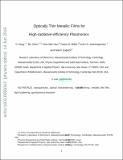| dc.contributor.author | Hsu, Chia Wei | |
| dc.contributor.author | Miller, Owen D. | |
| dc.contributor.author | Yang, Yi | |
| dc.contributor.author | Zhen, Bo | |
| dc.contributor.author | Soljacic, Marin | |
| dc.contributor.author | Joannopoulos, John | |
| dc.date.accessioned | 2017-06-15T14:37:34Z | |
| dc.date.available | 2017-06-15T14:37:34Z | |
| dc.date.issued | 2016-05 | |
| dc.date.submitted | 2016-02 | |
| dc.identifier.issn | 1530-6984 | |
| dc.identifier.issn | 1530-6992 | |
| dc.identifier.uri | http://hdl.handle.net/1721.1/109886 | |
| dc.description.abstract | Plasmonics enables deep-subwavelength concentration of light and has become important for fundamental studies as well as real-life applications. Two major existing platforms of plasmonics are metallic nanoparticles and metallic films. Metallic nanoparticles allow efficient coupling to far field radiation, yet their synthesis typically leads to poor material quality. Metallic films offer substantially higher quality materials, but their coupling to radiation is typically jeopardized due to the large momentum mismatch with free space. Here, we propose and theoretically investigate optically thin metallic films as an ideal platform for high-radiative-efficiency plasmonics. For far-field scattering, adding a thin high-quality metallic substrate enables a higher quality factor while maintaining the localization and tunability that the nanoparticle provides. For near-field spontaneous emission, a thin metallic substrate, of high quality or not, greatly improves the field overlap between the emitter environment and propagating surface plasmons, enabling high-Purcell (total enhancement >10[superscript 4]), high-quantum-yield (>50%) spontaneous emission, even as the gap size vanishes (3–5 nm). The enhancement has almost spatially independent efficiency and does not suffer from quenching effects that commonly exist in previous structures. | en_US |
| dc.description.sponsorship | National Science Foundation (U.S.). Materials Research Science and Engineering Centers (Program) (Grant DMR-1419807) | en_US |
| dc.description.sponsorship | United States. Department of Energy. Office of Science. Solid-State Solar Thermal Energy Conversion Center (Grant de-sc0001299) | en_US |
| dc.description.sponsorship | United States-Israel Binational Science Foundation (Award 2013508) | en_US |
| dc.description.sponsorship | Massachusetts Institute of Technology. Institute for Soldier Nanotechnologies (Contract W911NF-13-D-0001) | en_US |
| dc.language.iso | en_US | |
| dc.publisher | American Chemical Society (ACS) | en_US |
| dc.relation.isversionof | http://dx.doi.org/10.1021/acs.nanolett.6b00853 | en_US |
| dc.source | MIT Web Domain | en_US |
| dc.title | Optically Thin Metallic Films for High-Radiative-Efficiency Plasmonics | en_US |
| dc.type | Article | en_US |
| dc.identifier.citation | Yang, Yi et al. “Optically Thin Metallic Films for High-Radiative-Efficiency Plasmonics.” Nano Letters 16.7 (2016): 4110–4117. | en_US |
| dc.contributor.department | Massachusetts Institute of Technology. Department of Mathematics | en_US |
| dc.contributor.department | Massachusetts Institute of Technology. Department of Physics | en_US |
| dc.contributor.department | Massachusetts Institute of Technology. Research Laboratory of Electronics | en_US |
| dc.contributor.mitauthor | Yang, Yi | |
| dc.contributor.mitauthor | Zhen, Bo | |
| dc.contributor.mitauthor | Soljacic, Marin | |
| dc.contributor.mitauthor | Miller, Owen D. | |
| dc.contributor.mitauthor | Joannopoulos, John | |
| dc.relation.journal | Nano Letters | en_US |
| dc.eprint.version | Author's final manuscript | en_US |
| dc.type.uri | http://purl.org/eprint/type/JournalArticle | en_US |
| eprint.status | http://purl.org/eprint/status/PeerReviewed | en_US |
| dspace.orderedauthors | Yang, Yi; Zhen, Bo; Hsu, Chia Wei; Miller, Owen D.; Joannopoulos, John D.; Solja?i?, Marin | en_US |
| dspace.embargo.terms | N | en_US |
| dc.identifier.orcid | https://orcid.org/0000-0003-2879-4968 | |
| dc.identifier.orcid | https://orcid.org/0000-0002-7572-4594 | |
| dc.identifier.orcid | https://orcid.org/0000-0002-7184-5831 | |
| dc.identifier.orcid | https://orcid.org/0000-0003-2745-2392 | |
| dc.identifier.orcid | https://orcid.org/0000-0002-7244-3682 | |
| mit.license | PUBLISHER_POLICY | en_US |
